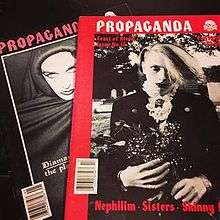Propaganda (magazine)
Propaganda was an American gothic subculture magazine. It was founded in 1982 by Fred H. Berger, a photographer from New York City. Berger's photography was featured prominently in the magazine. Propaganda focused on all aspects of the goth culture, including fashion, sexuality, music, art and literature. Propaganda was, at the time of its final issue in 2002, the longest running and most popular gothic subculture magazine in the United States.[1]
 Propaganda magazine, issues 17 & 18. The background copy features Diamanda Galas on the cover. | |
| Founder | Fred H. Berger |
|---|---|
| Year founded | 1982 |
| Final issue | 2002 |
| Country | United States |
| Based in | New Hyde Park, New York |
| ISSN | 0737-0776 |
History
Photographer and journalist Fred H. Berger was inspired to create Propaganda based on his interest in the gothic, industrial, darkwave, occult and fetish subcultures. Berger's official title was not editor-in-chief, but "Propaganda Minister".[2] Between 1991 and 1995 Propaganda produced three videos, The Trilogy, Blood Countess, and The Ritual. Blood Countess is about Elizabeth Bathory.[3] The magazine featured interviews and coverage of music acts such as Bauhaus, Xmal Deutschland, Laibach, Skinny Puppy, Fields of the Nephilim, Sisters of Mercy, Diamanda Galas, Jesus & Mary Chain, Siouxsie And The Banshees, Coil, Christian Death, Alien Sex Fiend, Swans, Legendary Pink Dots, My Life With the Thrill Kill Kult, Shadow Project, Xymox, Death in June, Dead Can Dance, Front Line Assembly, The Cure, Danzig and Love & Rockets.[2][4][5] Other subjects included articles about the Salem Witch Trials, the Holy Lance, Nazi-fetish chic, the Masque of the Red Death, Oscar Wilde, the Haunted Summer with Lord Byron and Mary Shelley, and queer chic authors Jean Genet and Yukio Mishima. Interviews with favorite goth authors Anne Rice and Poppy Z. Brite were also featured, as well as travel pieces such as "Old Haunts In New Orleans." [2][4]
Berger wrote most of the esoteric, historical and literary articles during the magazine's run. Music editors Paul Hart & Stephanie Young handled most of the music related aspects of the magazine from 1985 to 2002, interviewing bands and artists. Senior Editor George Petros wrote musical and artist features such as Genitorturers and H.R. Giger as well as news content for the Propaganda website from 2000 to 2005.[6][7] (The Propaganda website closed three years after the print magazine's termination.)
Photography
Berger's photography was a large focus for the magazine. Androgynous male models were commonly used.[1][8] Propaganda Issue No. 25 (Winter 1999) featured a heroin chic cover story called "Anarchy in Moscow" with photo essay by Berger. It was about a junkie hustler in Moscow during the social collapse of Russia after the fall of communism, and it generated more international interest than any article ever featured in Propaganda.
Legacy
Dark fantasy and horror writer Nancy Kilpatrick called Propaganda "probably the only subculture publication known to just about every goth on the planet," in her 2004 book The Goth Bible: A Compendium for the Darkly Inclined.[9] Rosemary Ellen Guiley described Berger as "a remarkable photographer who captures the eerie and macabre" in her 1994 book The Complete Vampire Companion.[10] Published by FIT in 2008, a particularly stylish and beautifully produced book is Gothic: Dark Glamour in which author Valerie Steele refers to Berger's photo shoots as "polymorphous perverse gothic fantasies." [11] Matt Riser, the publisher of Newgrave, another gothic subculture magazine, credited Propaganda as being an influence in him starting his own publication.[8]
References
- Lauren M. E. Goodlad; Michael Bibby (21 March 2007). Goth: Undead Subculture. Duke University Press. pp. 53–54. ISBN 978-0-8223-8970-5. Retrieved 2 March 2013.
- Propaganda (18). Spring 1992. Missing or empty
|title=(help) - J. Gordon Melton (1 September 2010). The Vampire Book: The Encyclopedia of the Undead. Visible Ink Press. p. 483. ISBN 978-1-57859-350-7. Retrieved 2 March 2013.
- Propaganda (17). Fall 1991. Missing or empty
|title=(help) - "Oh my goth: Dark, cultural phenomenon thriving, scholars say". University of Illinois. Retrieved 2 March 2013.
- Propaganda Magazine No. 27, Fall 2002, pp. 3.
- George Petros, Wikipedia article
- Nancy Kilpatrick (4 October 2004). The Goth Bible: A Compendium for the Darkly Inclined. Macmillan. pp. 17–18. ISBN 978-1-4299-7626-8. Retrieved 2 March 2013.
- Nancy Kilpatrick. The Goth Bible: A Compendium for the Darkly Inclined (2004). Macmillan. pp. 17–18. ISBN 978-1-4299-7626-8.
- Rosemary Ellen Guiley. The Complete Vampire Companion (1994). Macmillan USA. pp. vi, Acknowledgements. ISBN 0-671-85024-5.
- Valerie Steele and Jennifer Park. Gothic: Dark Glamour (2008). Yale University Press and Fashion Institute of Technology. pp. 44. ISBN 978-0-300-13694-4.